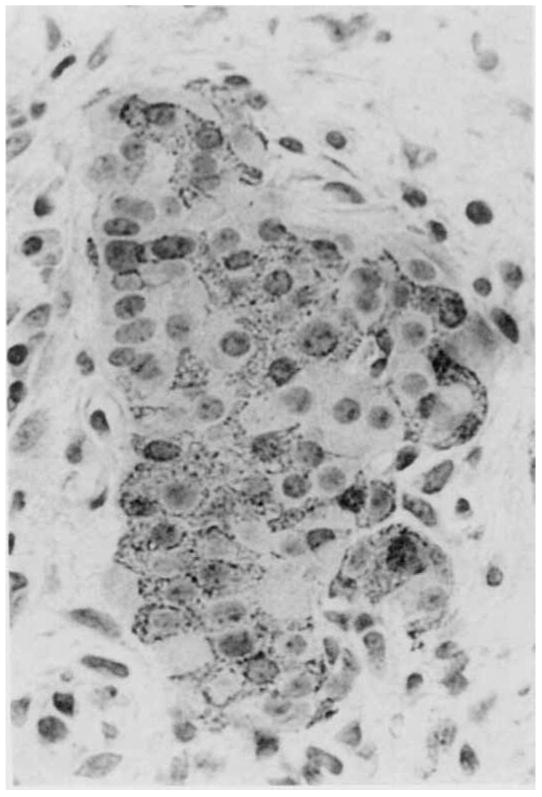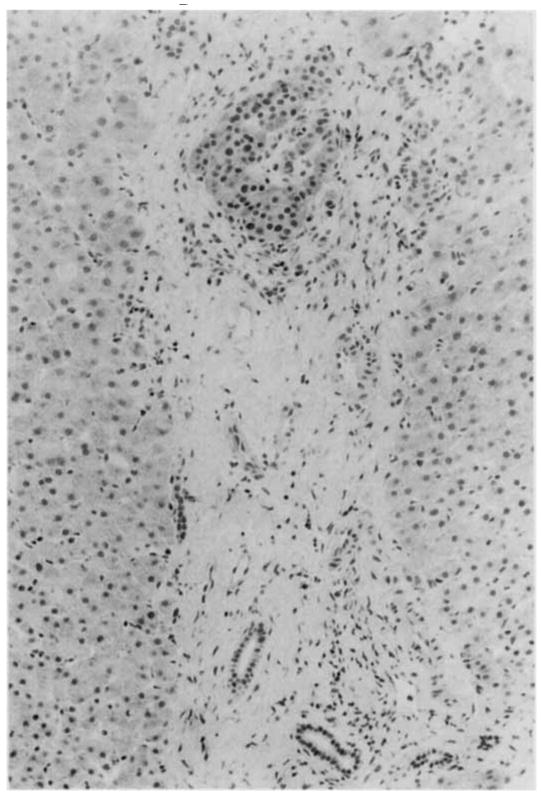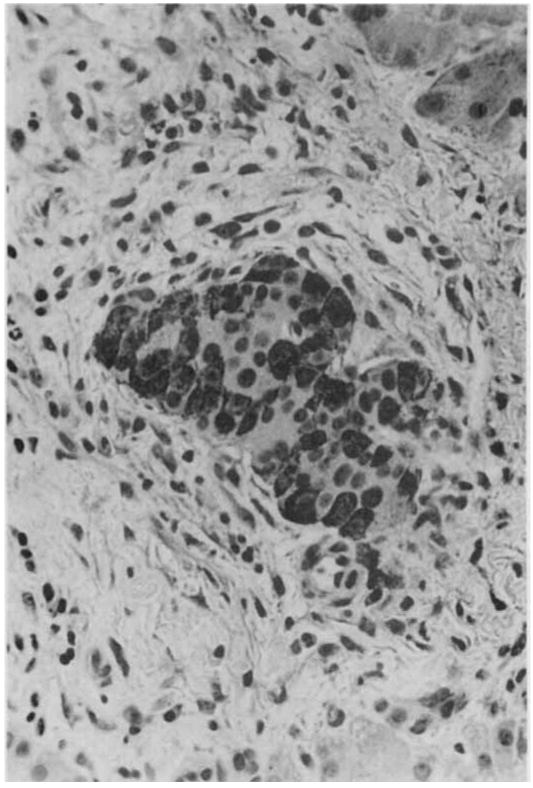Qualitative and quantitative standards have been recently proposed for islet isolation assessment in humans and large animals (1). The ultimate test of viability is functional activity after transplantation into a diabetic recipient. Morphologic identification of insulin-containing transplanted islets could provide important correlative data and eventually confirm the functional results. Recently, several centers reported prolonged insulin independence after human islet allotransplantation (2–5). The present report describes the first identification of islet tissue in a liver biopsy after intrahepatic islet allotransplantation in man. Human islets were obtained from 2 multiorgan donors by a modification (6) of the automated method for human islet isolation (7). The islets were purified on Eurocollins-Ficoll gradients (8) using a cell separator (9, 10) (COBE 2991, Lakewood, CO). On March 16, 1990 258,000 islets of an average diameter of 150 μ (1) were transplanted via portal vein injection following an upper abdominal exenteration and liver replacement (2). The procedure was performed in a 52-year-old woman for adenocarcinoma of the ampulla of Vater infiltrating the duodenal wall, with liver metastasis. Immunosuppression was with FK506 as described previously (2).
An exploratory laparotomy was performed 17 days after transplantation to rule out intraabdominal abscess. During the procedure a wedge biopsy was taken from the liver. A well-preserved human islet in a portal space (Fig. 1), with no significant surrounding inflammatory reaction was demonstrated. Immunohistochemical stains (immunoperoxidase) for insulin and glucagon confirmed the presence of beta (Fig. 2) and alpha (Fig. 3) cells. The insulin stain unequivocally demonstrated beta granulation in the majority of the islet cells. The alpha cells appeared more intensely stained for glucagon. A possible reason for the difference in stain intensity could be that total parenteral nutrition was administered to the patient. The hyperalimentation may have induced relative beta cell degranulation. An additional explanation may be that she received a marginal number of islets that could have been maximally stimulated. In support of this, she was the only one out of 9 patients who was still requiring daily insulin injections 4 months after transplantation (2). Nevertheless, islet function eventually improved, resulting in insulin independence 6 months after human islet transplantation.
Figure 1.

Liver biopsy showing a well-preserved human islet (top) in a portal space 17 days following human islet allotransplantation. No significant surrounding inflammatory reaction was observed (H & H & E; original magnification ×80).
Figure 2.

Human islet in liver biopsy after immunohistochemical stain (immunoperoxidase) for insulin. Beta granulations (dark) can be distinguished in the cytoplasm of the majority of the islet cells. (original magnification: ×350).
Figure 3.

Human islet in liver biopsy alter immunoperoxidase stain for glucagon (dark) showing well-granulated alpha cells (original magnification: ×200.
The morphologic documentation of intrahepatic pancreatic islet tissue following islet allotransplantation in man indicated that human islets can survive in the liver of transplanted patients, adding histologic evidence to previously reported functional results (2). A larger series of patients who received combined liver-islet or kidney-islet allografts is in progress (n=20).
This report provides the first evidence of islet tissue in a liver biopsy following human islet allotransplantation. These initial findings have been confirmed in other patients in whom islets have been found both in wedge and needle liver biopsies.
Footnotes
Supported in part by Research Grant No. 1911421 from the Juvenile Diabetes Foundation International, New York, New York.
References
- 1.Ricordi C, Gray DWR, Hering BJ, et al. Islet isolation assessment in man and large animals. Acta Diabetol Lat. 1990;27:185. doi: 10.1007/BF02581331. [DOI] [PubMed] [Google Scholar]
- 2.Tzakis A, Ricordi C, Alejandro R, et al. Pancreatic islet transplantation after upper abdominal exenteration and liver replacement. Lancet. 1990;336:402. doi: 10.1016/0140-6736(90)91946-8. [DOI] [PMC free article] [PubMed] [Google Scholar]
- 3.Scharp DW, Lacy PE, Santiago J, et al. Results of our first nine intraportal islet allografts in type I, insulin-dependent diabetic patients. Transplantation. 1991;51:76. doi: 10.1097/00007890-199101000-00012. [DOI] [PubMed] [Google Scholar]
- 4.Altman JJ, Cugnenc PH, Tessier C, et al. Epiploic flap: a new site for islet implantation in man. Horm Metab Res [Suppl] 1990;25:136. [PubMed] [Google Scholar]
- 5.Warnock GL, Kneteman NM, Ryan E, Seelis REA, Rabinovitch A, Rajotte RV. Normoglycemia after transplantation of freshly isolated and cryopreserved pancreatic islets in type I (insulin-dependent) diabetes mellitus. Diabetologia. 1991;34:55. doi: 10.1007/BF00404026. [DOI] [PubMed] [Google Scholar]
- 6.Ricordi C, Socci C, Davalli AM, et al. Isolation of the elusive pig islet. Surgery. 1990;107:688. [PubMed] [Google Scholar]
- 7.Ricordi C, Lacy PE, Finke EH, Olack BJ. An automated method for the isolation of human pancreatic islets. Diabetes. 1988;37:413. doi: 10.2337/diab.37.4.413. [DOI] [PubMed] [Google Scholar]
- 8.Scharp DW, Lacy PE, Santiago JV, et al. Insulin independence after islet transplantation into type I diabetic patients. Diabetes. 1990;39:515. doi: 10.2337/diab.39.4.515. [DOI] [PubMed] [Google Scholar]
- 9.Lake SP, Bassett PD, Larkins A, et al. Large-scale purification of human islets utilizing discontinuous albumin gradient on IBM 2991 cell separator. Diabetes. 1989;38(suppl):143. doi: 10.2337/diab.38.1.s143. [DOI] [PubMed] [Google Scholar]
- 10.Alejandro R, Strasser S, Zucker PF, Mintz DH. Isolation of pancreatic islets from dogs: semiautomated purification on albumin gradients. Transplantation. 1990;50:207. doi: 10.1097/00007890-199008000-00007. [DOI] [PubMed] [Google Scholar]


